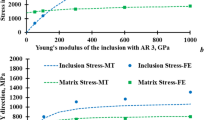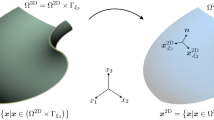Abstract
THE concept of the stress intensity factor K has proved particularly useful in the study of opening mode crack growth problems where the nominal stress level is well below the yield stress of the material. Closed-form solutions for stress intensity factors can be obtained by analytical methods, but these are limited to a few restricted cases. Computer programs, based either on the boundary collocation of a stress function or on complex variable mapping methods, have been used to obtain the opening mode stress intensity factor K1 for various two-dimensional geometries1. Semi-empirical methods have also been proposed2. There is, however, still a need for a general method, with a sound theoretical basis, for calculating K1 for cracks in bodies of arbitrary shape.
Similar content being viewed by others
References
Brown, W. F., and Srawley, J. E., ASTM STP 410 (American Society for Testing and Materials, Philadelphia, 1966).
Williams, J. G., and Isherwood, D. P., J. Strain Anal., 3(1), 17 (1968).
Paris, P. C., and Sih, G. C., ASTM STP 381 (American Society for Testing and Materials, Philadelphia, 1965).
Author information
Authors and Affiliations
Rights and permissions
About this article
Cite this article
DIXON, J., POOK, L. Stress intensity Factors calculated generally by the Finite Element Technique. Nature 224, 166–167 (1969). https://doi.org/10.1038/224166a0
Received:
Issue Date:
DOI: https://doi.org/10.1038/224166a0
- Springer Nature Limited
This article is cited by
-
Matrix cracking initiated by fibre breaks in model composites
Journal of Materials Science (1992)
-
Variational approach for a new direct-integration form of the virtual crack extension method
International Journal of Fracture (1988)
-
Stress intensity factors for cracks in a plate containing a hole and in a spinning disc
International Journal of Fracture (1973)





